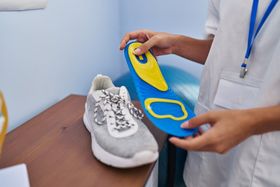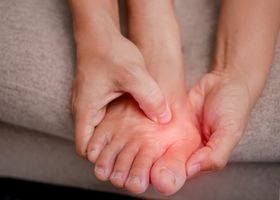Running With Flat Feet: All You Need to Know to Prevent Injury
Updated October 8, 2024

Having flat feet is a common condition affecting many people around the world. It is characterized by a loss of arch height when weight is taken through the foot. While some develop symptoms like pain in the feet and lower legs, many people with flat feet can still participate in running and other physical activities largely symptom-free.
Causes and Complications of Flat Feet
Causes of Flat Feet
Flat feet are usually seen in young children. As children grow, their arches strengthen to support more weight while walking. Flat feet in adulthood are typically a result of the arches not developing during adolescence. A sudden loss of arch height in adulthood is uncommon and could indicate a more serious issue.
Flat feet can be a result of a variety of factors and conditions, including:
- Genetics
- Overuse and strain
- Ligament laxity in the lower leg and structures of the foot
- Shortened or “tight” Achilles tendon
- Loss of intrinsic foot muscle strength
- Injury to the foot, affecting the structures of the arch
- Arthritis
- Diabetes
- Obesity
- Pregnancy
Complications of Flat Feet
Flat feet are associated with a range of potential complications, which usually present themselves when the condition hasn't been sufficiently managed. Complications can arise after excessive exercise or physical activity when incorrect, unsupportive, or rigid footwear is worn, or when walking or running barefoot on hard surfaces.
Some examples of complications include:
- Pain in the arch or heel
- Shin pain/shin splints
- Bunions & calluses
- Hammertoes
- Numbness in the foot
- Reduced mobility
- Back pain
- Muscles in the foot fatigue quickly
How to Prevent Injury When Running With Flat Feet
Products to Use
There are many products that provide the necessary support to prevent injuries or pain from occurring when running. They lower the strain placed on the lower leg while doing endurance running activities, which minimizes your chances of developing an overuse injury. Using insoles designed specifically for flat feet is a good start.
Custom running orthotics that fit correctly in your running shoe, without compromising comfort, are a good option for preventing complications from running with flat feet. The orthotics will prop the arch up when weight is applied, preventing the arch from dropping and the inward turn of the tibia, which is commonly associated with flat feet.
This takes the strain off the rest of the body that is actively compensating for the reduced contribution of the feet to the gait cycle. Energy can therefore be used more efficiently, allowing you to run with better efficiency, without the risk of injury.
Techniques to Practice
Exercise in conjunction with orthotics or supportive footwear can help align your feet and legs. As you run, your muscles fatigue, which causes pain after covering some distance.
Exercises can strengthen the muscles of the foot that actively support the arch and lengthen some of the structures that may contribute to pulling the arch downwards. Other remedies, including self-massage, weight loss, and rest can also aid in relieving symptoms of flat feet.
You can try the exercises below to target these structures and reduce overpronation. They can be done as a warm-up for running or in preparation for daily activities.
- Arch squeeze: While sitting with your foot flat on the floor, slide the forefoot backward, toward your heel, and squeeze the arch. Hold it for 10-15 seconds. Relax the foot and repeat about 10 times per foot.
- Calf stretches: These can be done against a wall or using a step. Place your weight on your forefoot, usually one leg at a time, and slowly attempt to lower the heel to the ground. You should feel a gentle stretch at the back of the leg. Hold it for 15-30 seconds for true muscle lengthening.
- Foot stretches: Stretching the foot muscles can help relieve pain and muscle fatigue. Sitting on a chair, bring one leg up to rest horizontally over your other leg with your toes facing forward. Apply a gentle stretch to the toes, stretching them backward. Hold it for 15-20 seconds, then release. Repeat 4 or 5 times for each foot.
- Heel raises: Heel raises strengthen the muscles of the foot and lower leg that support the arch, and subsequently, the weight of the whole body. This exercise should be done on a soft surface, preferably barefoot. Standing with your feet shoulder-width apart, raise your heels off the ground, going up onto the forefoot and toes. Hold for a second or two, and then lower the heels to the ground again. Repeat 10-15 times, and repeat 2 or 3 times a day.
Should You Run With Flat Feet?
With the necessary self-management for flat feet, you can run and do all your normal daily activities with few symptoms. The combination of exercises and orthotics aids in maintaining your foot arch and preventing strain injuries during endurance activities. Should adverse symptoms persist, consult a medical practitioner for professional care.








